Our Universe has at least one sextillion planets. A sextillion is a number so huge, it’s virtually impossible to imagine, but to put it into some kind of context, the Earth weighs about a sextillion times more than a polar bear. It’s a big number.
But every single one of the sextillion planets in the Universe is round. There isn’t a single cuboid, dodecahedral or Toblerone-shaped one among them.
Why are planets round?
A planet begins as a cloud of rocks and dust particles rotating around a star. The particles attract each other due to gravity, until they form a single blob. As that blob attracts more matter, it gets bigger and bigger, until it has collected everything in its path.
Since gravity works in all directions equally, the blob becomes round. Imagine a crowd of a thousand people all trying to get as close as possible to a circular bar in a pub. If the queue was six deep on one side of the bar and two deep on the other, then new arrivals would join the shorter queue and eventually the queues would even out, leaving a circular throng of thirsty punters. That’s how gravity works in this case.

Are planets a perfect sphere?
The roundness is not perfect. The Earth, for example, is an ‘oblate spheroid’: it’s nearly spherical but has a bulge at the middle. This is because of the planet’s spin.
Every time the Earth rotates once on its axis, the middle travels further than the top. This means that land at the equator is moving faster than land at the poles, and the faster something spins, the more it is thrown outwards.
Just like the rest of us, once it reaches a certain age, a new planet always gets a bulge around its middle. The Earth’s spare tyre is not very big: a hole through the planet would be only about 43 kilometres longer if it started at the equator than if it was pole to pole.
The effect is much bigger on other planets that are not quite so solid. Saturn, which is largely made of gas, has a diameter that is 11,000 kilometres longer between two points on its equator than between its poles. This extra thickness can yield dramatic results too: if a planet gathers enough extra mass around its middle, the whole lot can be flung into space, eventually forming into a moon. But if you’re hoping for a cube-shaped moon, you’ll be waiting for quite a while.
Are all moons round?

Asteroids and moons are smaller than planets, so they have less gravity, and this means they’re less round. Comet 67P, pictured above, is a trillionth of the weight of Earth (it weighs about the same as a billion polar bears) and is shaped like a very odd rubber duck.
Read more:
Also from the QI Elves:
The ‘QI Elves’ are the team of researchers and writers behind BBC Two’s smash hit comedy panel show QI. Their latest book is Funny You Should Ask (£12.99, Faber) and is out now.
- Buy now from Amazon UK, Foyles, Waterstones and WHSmith
- Listen to our podcast collab with No Such Thing as a Fish, the spin-off QI podcast by the Elves
